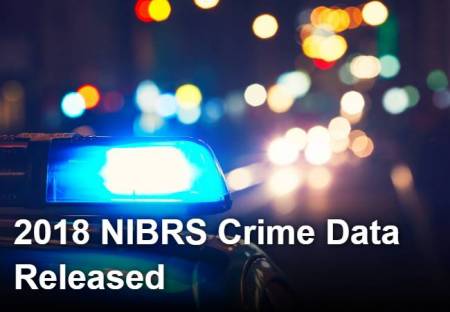
FBI Releases 2018 NIBRS Crime Data as Transition to NIBRS 2021 Continues
The FBI released detailed data on nearly 6.6 million criminal offenses reported via the National Incident-Based Reporting System (NIBRS) in 2018. The Uniform Crime Reporting (UCR) Program’s latest report, NIBRS, 2018, presents data about victims, known offenders, and relationships for offenses reported in 52 categories. In addition, the report provides information on arrests for those crimes as well as 10 additional categories for which only arrest data is collected.
Highlights of NIBRS, 2018
In 2018, 7,283 law enforcement agencies, whose jurisdictions covered more than 117.1 million U.S. inhabitants, submitted NIBRS data to the UCR Program. These agencies comprised 43.7 percent of the 16,659 law enforcement agencies that submitted data to the UCR Program in 2018. Based on NIBRS submissions, the FBI compiled aggregate tables on 5,617,945 incidents involving 6,586,140 offenses, 6,944,242 victims, 5,652,156 known offenders, and 3,480,625 arrestees. (Currently, the FBI does not estimate for agencies that do not submit NIBRS data.)
Of the reported offenses, 59.5 percent were crimes against property, 24.1 percent were crimes against persons, and 16.4 percent were crimes against society. Among these categories, the offenses most reported include larceny/theft offenses, assault offenses, and drug/narcotic offenses, respectively.
2018 NIBRS Crime Data Released
Victims
Victim types, collected for all reported NIBRS offenses, include individuals, businesses, institutions, or society as a whole. For 2018, the data regarding victims who were individuals revealed the following:
- Of the 4,720,900 individuals, 23.5 percent were between 21 and 30 years of age.
- A little more than half (51.1 percent) were female, 48.1 percent were male, and the gender of 0.8 percent of victims was unknown.
- Most victims (69.6 percent) were white, 21.6 percent were black or African-American, 1.9 percent were Asian, 0.7 percent were American Indian or Alaska Native, and 0.4 percent were Native Hawaiian or Other Pacific Islander. The race of 5.8 percent of victims was unknown.
Known Offenders
In 2018, law enforcement identified and reported information on 5,652,156 known offenders, meaning some aspect of the suspect—such as age, gender, or race—was known.
- Of these offenders, 40.2 percent were between 16 and 30 years of age.
- By gender, most offenders (61.5 percent) were male, 25.5 percent were female, and gender for 13.0 percent was unknown.
- By race, more than half (53.9 percent) of known offenders were white, 27.4 percent were black or African-American, and 2.2 percent were of other races. The race was unknown for 16.5 percent of reported known offenders.
Victim-to-Offender Relationships
Concerning the relationship of victims to known offenders, there were 1,593,326 victims of crimes against persons (e.g., murders, sex offenses, assault offenses) and robbery offenses from the crimes against property category.
- More than half (51.0 percent) of the victims knew their offenders (or at least one offender when more than one was present) but did not have a familial relationship to them.
- Nearly one quarter (24.7 percent) of the victims were related to their offenders (or at least one offender when more than one was present).
Arrestees
Law enforcement agencies submitted data to the UCR Program through incident reports and arrest reports for 3,480,625 arrestees.
- Of these arrestees, 32.5 percent were 21 to 30 years of age.
- By gender, 71.4 percent were male, and 28.6 percent were female.
- By race, most arrestees (69.6 percent) were white, 24.7 percent were black or African-American, and 2.9 percent were of other races. The race was unknown for 2.8 percent of arrestees.
Agency-Level NIBRS Data
The interactive NIBRS map on the home page of NIBRS, 2018 provides agency-level data. In addition, state offense tables present statistics for each agency that reported 12 months of NIBRS data in 2018.


Georgia Lifestyle
DNR: Clean Feeders Save Birds

Crime & Safety
Body Found in Baldwin County Missing Person Investigation

Bulloch Public Safety
04/25/2024 Booking Report for Bulloch County

Bulloch Public Safety
04/09/2024 Booking Report for Bulloch County

Bulloch Public Safety
04/01/2024 Booking Report for Bulloch County

Bulloch Public Safety
04/08/2024 Booking Report for Bulloch County

Bulloch Public Safety
04/22/2024 Booking Report for Bulloch County

Bulloch Public Safety
04/15/2024 Booking Report for Bulloch County





